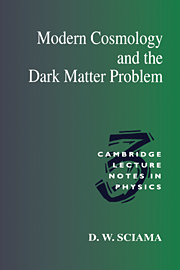Book contents
- Frontmatter
- Contents
- Preface
- Recent Developments
- Part One Dark Matter in Astronomy and Cosmology
- Part Two Ionisation Problems in Astronomy and Cosmology
- 5 Diffuse Ionisation in the Milky Way
- 6 Diffuse Ionisation in Spiral Galaxies
- 7 The Intergalactic Flux of Hydrogen-Ionising Photons
- Part Three Neutrino Decay and Ionisation in the Universe
- Part Four Observational Searches for the Neutrino Decay Line
- References
- Subject index
5 - Diffuse Ionisation in the Milky Way
Published online by Cambridge University Press: 11 January 2010
- Frontmatter
- Contents
- Preface
- Recent Developments
- Part One Dark Matter in Astronomy and Cosmology
- Part Two Ionisation Problems in Astronomy and Cosmology
- 5 Diffuse Ionisation in the Milky Way
- 6 Diffuse Ionisation in Spiral Galaxies
- 7 The Intergalactic Flux of Hydrogen-Ionising Photons
- Part Three Neutrino Decay and Ionisation in the Universe
- Part Four Observational Searches for the Neutrino Decay Line
- References
- Subject index
Summary
Introduction
The interstellar medium of our Galaxy contains a widespread component of ionised gas with fairly well-determined average properties. The source of the ionisation has puzzled astrophysicists for many years (e.g. Mathis 1986, Kulkarni and Heiles 1987, Reynolds 1991, 1992, Walterbos 1991, Heiles 1991). There are five major problems which contribute to the mystery. They are the following:
(i) The scale height of the ionised gas ∼ 670 pc (Nordgren et al. 1992), whereas the sources usually considered (e.g. ionizing radiation from 0 stars or supernovae) have a much smaller scale height (∼ 100 pc).
(ii) The power requirements which the sources must satisfy in order to maintain the ionisation are rather large and probably rule out any conventional source except 0 stars (Reynolds 1990b).
(iii) The interstellar medium is normally regarded as being highly opaque to hydrogen-ionising radiation, so that it is not clear how this radiation can travel hundreds of parsecs from the parent 0 stars to produce the diffuse ionised gas (Mathis 1986, Reynolds 1984, 1987, 1992, Heiles 1991).
(iv) The same opacity problem arises when one studies in detail (Reynolds 1990a) the ionisation along the line segments to two pulsars with accurately known parallactic distances.
(v) The mean electron density in opaque intercloud regions within a few hundred parsecs of the sun is remarkably constant in different directions (Reynolds 1990a, Sciama 1990c). If the opaque gas has a sufficiently tortuous distribution to explain problem (iii), it is surprising that the resultant electron density is so uniform.
In this chapter we shall elaborate on these problems.
- Type
- Chapter
- Information
- Modern Cosmology and the Dark Matter Problem , pp. 77 - 94Publisher: Cambridge University PressPrint publication year: 1994



